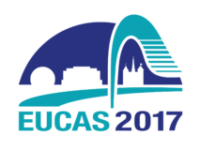Speakers
Description
Abstract
This course covers the design of superconducting magnets for particle accelerators and detectors. The lectures are intended for physicists and engineers working in the areas of magnet technology and applied superconductivity, and interested in basic principles, physical parameters, analytical and numerical tools used for superconducting magnet design. For each of the applications considered, the courses will start by presenting the properties and characteristics of superconducting strands and cables. The main concepts related to magnetic design and coil lay-outs will be then outlined. In addition, the lectures will deal with the mechanics and fabrication techniques of a superconducting magnet, focusing in particular on coils and the structural components aimed at containing the electro-magnetic forces and managing the stresses. Finally, a description of the different systems devoted to cool and protect a magnet after a quench will be provided.
Speaker Bio.
Paolo Ferracin
Paolo Ferracin is currently a staff scientist in the Magnets, Superconductors and Cryostats (MSC) Group at the European Organization for Nuclear Research (CERN) in Geneva. After graduating in Nuclear Engineering at the Politecnico of Torino, Italy in 1998, he joined the CERN Main Magnet and Superconductors Group as a PhD Student to work on the mechanics and magnetics of the main superconducting dipole magnets for the Large Hadron Collider (LHC). In May 2002, he started working in the Superconducting Magnet Program of Lawrence Berkeley National Laboratory (LBNL), first as a Physicist Postdoctoral Fellow and then as a Staff Scientist, on the development of Nb3Sn dipoles and quadrupoles for the next generation particle accelerators. In 2011, he re-joined the MSC group at CERN. For the past 19 years, he has conducted research in the area of applied superconductivity and superconducting magnet technology for particle accelerators.
Hermann Ten Kate
Herman ten Kate received his Bachelor degree from the University of Twente in 1976, his M.Sc. degree in Applied Physics and Superconductivity in 1980 (for research on superconducting switches and transformers) and his Ph.D. degree for thesis research on ‘Superconducting Rectifiers” in 1985. In 1985 he became an assistant professor at the University of Twente and was the leader of the High Current Superconductivity Group from 1991 though 1996. In 1997, Prof. Ten Kate was appointed to a special chair as Extraordinary Professor for Industrial Applications of Superconductivity. In 1996 he accepted an appointment at CERN where he worked on a number of projects developing high performance, high field superconducting magnets for particle accelerator applications as a staff member of the Physics Department and became the ATLAS Magnet Systems Project Leader. The ATLAS Magnet system is the largest superconducting magnet system built for particle accelerator applications and played a critical role on the recent discovery of the Higgs boson. In addition to ATLAS he and his team is involved in problems solving for various detector magnets at CERN, as well as design of new detector magnets for ILC, IAXO and PANDA and is leading the design of the new detector magnets for the Future Circular Collider.




